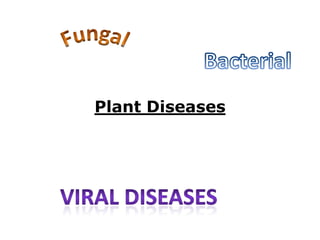Plant Diseases 170312 V1
- 3. Damping Off Non-chemical control Raise seedlings in commercial growing compost. Sterilisation to destroy pathogens. Ideally, use new pots and trays. Sow seedlings thinly to avoid crowding. Use mains water if possible when irrigating. Do not overwater. Keep seedlings well ventilated to reduce humidity. Soil-borne fungi including Pythium, Rhizoctonia & Chemical control Fusarium, The copper fungicide Fruit and Vegetable Disease which infect seedlings and cause Control is very effective if applied as a them to ‘damp off’ or collapse preventative drench to seed trays. and decay.
- 5. Botrytis cinerea Economically Important To minimize infection in strawberry fields, good ventilation around the berries is important to prevent moisture being trapped among leaves and berries. May cause "winegrower's lung”
- 7. Cane Spot [Elsinoe veneta] Over winters on the canes! First appear on the lower parts of the canes, & gradually work their way upwards. The marks tend to be in the shape of a 'squashed' circle (elliptical) and are rarely larger than 1cm (1/4 in) long. Regular clearing of debris at the base of the plant will prevent it's spread.
- 9. Spur Blight [Didymella applanata] Purple patches. Rarely kills raspberries - reduce yield & weakens canes/killing buds. Appears from late summer and persists on infected canes until the following year. Particularly common during wet seasons. Fruiting bodies of the fungus may be visible as tiny black spots on the affected areas. Many of the buds on canes infected the previous year fail to grow. Copper oxychloride - spray canes in spring or evening. Resistant cultivars -‘Glen Lyon’, ‘Glen Moy’, ‘Glen Rosa’, ‘Julia’, ‘Leo’ & ‘Malling Admiral’
- 11. Rust [Fungi of the order Pucciniales] Disease is systemic Reducing blossoming and fruit set Does not kill - no value Source of inoculums - spreading the disease Good hygiene & careful watering Destroy Fugicides such as Mancozeb or Triforine Organic preventative - Sulphur powder Most harmful pathogens to agriculture & horticulture
- 13. Tulip Fire [Botrytis tulipae] Spores attack emerging tulip leaves Brown spots leading to rotting – foliage & flowers In heavy rain the flower stem collapses & the whole plant can end up covered in fungus Destroy Plant in November, rather than early autumn – soils are colder, so the fungus is less likely to spread
- 15. Fire Blight [erwinia amylovora] Rosebushes, Apple & Pear Trees Attacks blossoms or flowers & moving up to the twigs and branches Flowers turn brown & wilt - twigs shrivel & blacken Advanced cases - cankers, discoloured oozing patches Amber or reddish ooze contains masses of bacteria Heavy persistent infections can be fatal
- 17. Crown Rot Hemerocallis [Daylily] & Hosta Leaves start to discolour, wither, and die off – whole plant may droop Stems my darken in colour, have a slick texture or mushy feeling Avoid over watering or allowing plants to dry out totally
- 19. Parsnip Canker [Itersonilia pastinacae] Orange, brown or purple-coloured rot usually starts at the top of the root Drought, over-rich soil or damage to the crown e.g. Carrot-fly injury and damage from hoeing Low or acid pH also makes the disease more likely and more severe Sow resistant cultivars such as ‘Avonresister’ & ‘Archer’ Avoid sowing seeds too early in the year
- 21. Halo Blight [Pseudomonas syringae pv. Phaseolicola] Water droplets - rain or watering carry the spores Plant disease-free seed, rotate crops Destroy Soap-Shield® Fungicidal Soap [US] or Copper Fungicides at 7-10 day intervals
- 23. Tomato Mosaic Virus [ToMV] Light & dark green mottling of the leaf tissue and stunting of the plant Upward leaf rolling & stem streaking depending on which strain of ToMV Resistant varieties is the best way to reduce losses from this disease Avoid planting in soil from previous crops that were infected with ToMV Snapping off suckers without touching the plant instead of knife pruning can help reduce disease incidence
- 25. Tomato Spotted Wilt Virus [TSWV] Serious diseases of many economically Destroy important plants representing 35 plant families, dicots & monocots TSWV transmitted by certain thrips Symptoms expressed on leaves, petioles, stems & fruit Young leaves may show small, dark-brown spots and eventually die Dark brown streaks also appear on stems and leaf petioles Growing tips are usually severely affected with complete cell death & greatly stunted growth
- 27. Potato Leaf Roll Virus [PLRV] Coarse, brittle & rolled along midrib Significant yield & quality losses

